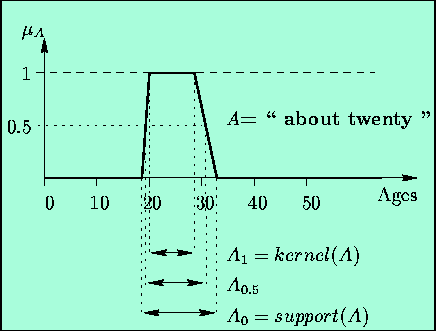 |
 |
![]()
![]()
When we build an ![]() -cut
-cut
![]() of fuzzy subset A, we can say that
of fuzzy subset A, we can say that ![]() represents the threshold from which
the concept of membership, although relative in the definition of A,
is regarded as sufficient to build its approximate subset
represents the threshold from which
the concept of membership, although relative in the definition of A,
is regarded as sufficient to build its approximate subset ![]() .
.
The more demanding we are about the concept of membership, the more
this threshold is raised, and the fewer elements of ![]() satisfy the membership criteria. The
satisfy the membership criteria. The ![]() -cuts
of A are nonfuzzy parts of
-cuts
of A are nonfuzzy parts of ![]() , encapsulated with respect to the value of
, encapsulated with respect to the value of ![]() ,
i.e. if
,
i.e. if ![]() ,
then
,
then ![]() .
.
 |
Operations on fuzzy sets are compatible with the classical operations of crisp sets.
Thus, for all A and B of ![]() and for all
and for all ![]() of [0, 1], performing the fuzzy intersection or union of A and B,
and then constructing
of [0, 1], performing the fuzzy intersection or union of A and B,
and then constructing ![]() -cuts,
is equivalent to seeking the
-cuts,
is equivalent to seeking the ![]() -cuts
of A and B and then performing their classical
intersection or union:
-cuts
of A and B and then performing their classical
intersection or union:
If level ![]() is selected, then
is selected, then ![]() .
If level
.
If level ![]() is selected, then
is selected, then ![]() is the kernel of A, which could be empty.
is the kernel of A, which could be empty.